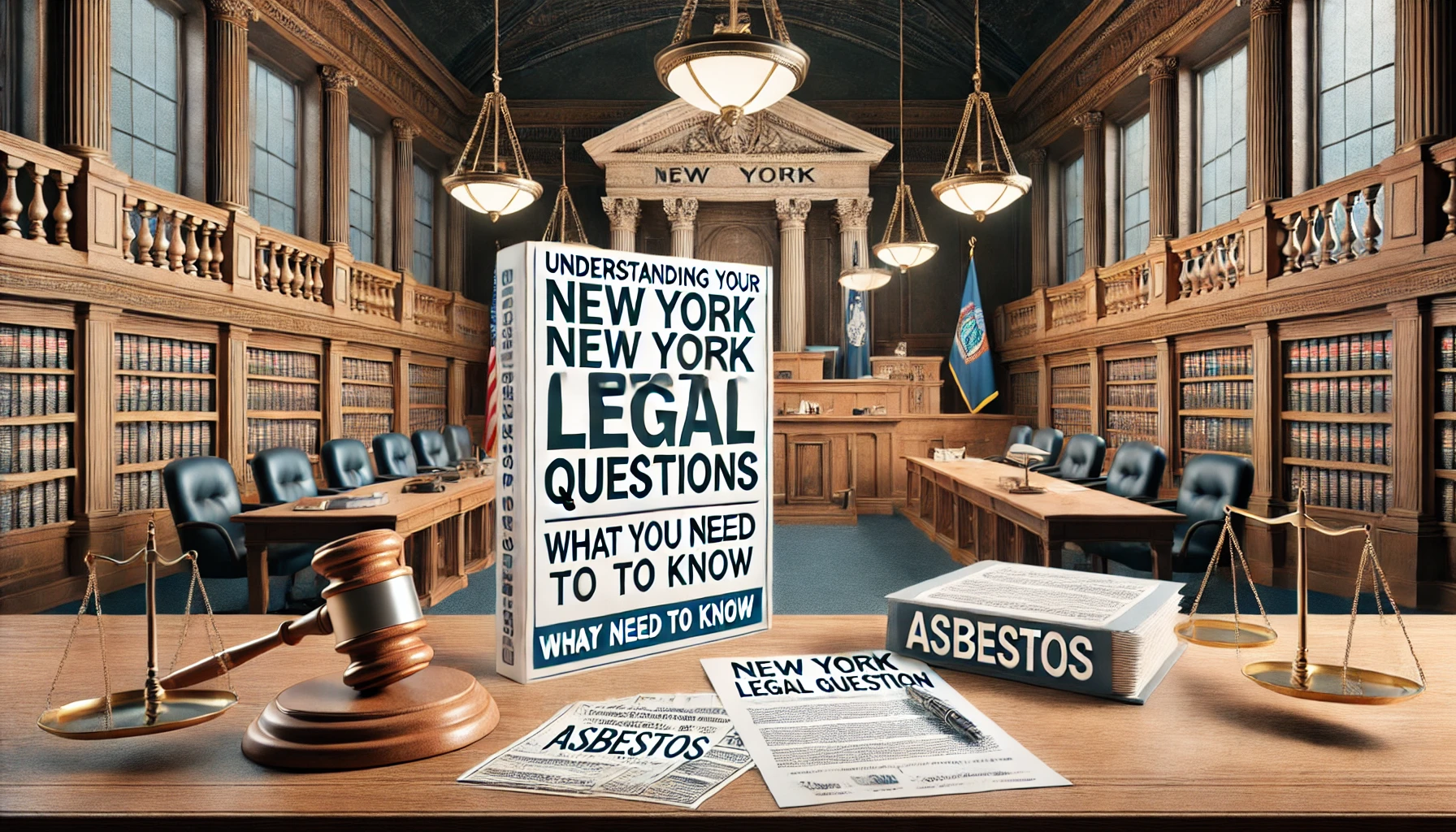Introduction to Asbestos and Legal Concerns in New York
Asbestos is a naturally occurring mineral that was once widely used in construction and various industries for its heat resistance and durability. However, it was later discovered that asbestos exposure can lead to severe health issues, including lung cancer and mesothelioma. This discovery turned asbestos into a serious legal issue, particularly in states with a heavy industrial presence like New York.
In New York, asbestos-related legal questions are incredibly important because the state has a long history of industrial activity, especially in areas like shipbuilding, manufacturing, and construction. These industries heavily utilized asbestos, leading to widespread exposure among workers and residents.
New York has become a focal point for asbestos litigation due to its high number of cases and the complexity of laws surrounding asbestos claims. The state’s industrial legacy means that many individuals are now seeking justice and compensation for illnesses linked to asbestos exposure. Addressing asbestos-related legal concerns in New York is crucial, not only for those affected but also for ensuring that companies are held accountable for their past practices.
Understanding Asbestos Laws in New York
Federal vs. State Regulations:
In the United States, asbestos regulation is governed by both federal and state laws. Federal regulations like the Clean Air Act (CAA) and the Asbestos Hazard Emergency Response Act (AHERA) set the foundation for asbestos control across the country. However, New York has implemented its own state-specific regulations that often go beyond federal guidelines, ensuring stricter control and protection for its residents. Understanding the differences between these two sets of regulations is essential for anyone involved in asbestos litigation in New York.
New York Asbestos Control Program:
New York has established a robust Asbestos Control Program that outlines specific requirements for the handling, removal, and disposal of asbestos-containing materials. This program is designed to protect public health by ensuring that asbestos abatement is carried out safely and effectively. The state’s regulations require licensed contractors to follow strict guidelines, including air monitoring, site inspections, and worker training. These laws are enforced by the New York State Department of Labor and the Department of Environmental Conservation, making New York one of the most regulated states in terms of asbestos control.
Statute of Limitations for Asbestos Claims in New York:
In New York, the statute of limitations for filing an asbestos-related lawsuit is critical information for anyone affected by asbestos exposure. Generally, individuals have three years from the date of diagnosis of an asbestos-related illness to file a personal injury claim. For wrongful death claims, the family has two years from the date of the victim’s death. It’s important to understand these time limits because missing the deadline can result in the loss of the right to seek compensation. Acting swiftly and consulting with a knowledgeable attorney is crucial for anyone considering an asbestos claim in New York.
Common Legal Questions About Asbestos in New York
Who Can File an Asbestos Claim?
In New York, individuals who have been diagnosed with an asbestos-related illness, such as mesothelioma or lung cancer, are eligible to file an asbestos claim. This includes not only those who were directly exposed to asbestos in the workplace but also individuals who experienced secondary exposure (e.g., family members who were exposed to asbestos fibers brought home on clothing). Additionally, the surviving family members of someone who has passed away due to an asbestos-related illness can file a wrongful death claim.
What Types of Asbestos Claims Can Be Filed?
New York allows for several types of asbestos claims. The most common are personal injury claims, where individuals seek compensation for the physical and emotional damages caused by asbestos exposure. Wrongful death claims can be filed by the families of those who have died due to asbestos-related illnesses. Property damage claims are also an option, typically filed when asbestos contamination has resulted in a loss of property value or required costly remediation efforts.
What Compensation Can Be Expected?
Victims of asbestos exposure in New York may be entitled to various forms of compensation. This can include medical expenses for treatments related to asbestos-related illnesses, lost wages due to the inability to work, and punitive damages if the exposure was due to willful negligence by a company or employer. The amount of compensation can vary based on factors such as the severity of the illness, the impact on the victim’s quality of life, and the evidence presented in the case.
How to Prove Exposure to Asbestos?
Proving exposure to asbestos is a critical aspect of any asbestos claim in New York. Victims need to provide solid evidence linking their illness to asbestos exposure. This typically involves medical records, work history documentation, and witness statements. Additionally, expert testimony may be required to establish a connection between the victim’s illness and the specific asbestos products or work environments involved. Thorough documentation and a clear timeline of exposure are essential to building a strong case and securing fair compensation.
Recent Case Studies and Notable Asbestos Lawsuits in New York
High-Profile Asbestos Cases in New York:
New York has seen several high-profile asbestos lawsuits that have garnered significant attention. One such case is the landmark suit against Johns-Manville Corporation, a major manufacturer of asbestos products. The company faced multiple lawsuits from workers and their families, ultimately leading to the establishment of a compensation trust fund for victims. Another notable case involved the Chrysotile Institute, where plaintiffs successfully proved that the organization knowingly downplayed the risks of asbestos, resulting in substantial settlements for the affected individuals.
Lessons Learned from Recent Cases:
Recent asbestos cases in New York have highlighted the importance of thorough documentation and expert testimony. These cases show that clear evidence linking exposure to specific asbestos-containing products is crucial in securing favorable outcomes. Additionally, the success of wrongful death claims underscores the need for families to act promptly in filing claims to ensure they meet the statute of limitations. The aggressive legal strategies used by plaintiffs’ attorneys have also set a precedent for holding corporations accountable for past negligence.
Impact of These Cases on Current Legal Trends:
The outcomes of these high-profile lawsuits have had a significant impact on current legal trends in New York. Courts are increasingly siding with plaintiffs, particularly in cases where companies have been found to have concealed information about the dangers of asbestos. This shift has led to higher settlements and jury awards, encouraging more victims to come forward and file claims. Additionally, these cases have spurred stricter regulations and increased awareness of asbestos-related risks, influencing both legislation and litigation strategies across the state.
Legal Challenges and Complexities in Asbestos Cases
Challenges in Proving Causation:
One of the most significant challenges in asbestos cases is proving causation—establishing that asbestos exposure directly caused the illness in question. Since asbestos-related diseases like mesothelioma and lung cancer can take decades to develop, it becomes difficult to pinpoint the exact source and time of exposure. Additionally, many victims have had multiple potential exposures throughout their lives, further complicating the ability to prove that a specific exposure was the definitive cause of their illness. This makes the legal process particularly challenging for plaintiffs who must provide convincing evidence to support their claims.
The Role of Expert Witnesses:
In asbestos litigation, expert witnesses play a crucial role in bridging the gap between exposure and illness. These experts, often medical professionals or occupational safety specialists, provide testimony on the link between asbestos and the specific disease. Their insights help the court understand the complex science behind asbestos-related illnesses, making their testimony pivotal in determining the outcome of the case. Without strong expert testimony, it can be nearly impossible to prove causation, making these witnesses indispensable in asbestos cases.
Multi-Party Litigation and Bankruptcy Issues:
Asbestos cases often involve multi-party litigation, where multiple defendants, such as manufacturers, suppliers, and employers, are sued simultaneously. This complexity is heightened when one or more of the defendants have declared bankruptcy, a common occurrence in asbestos-related litigation due to the overwhelming number of claims against these companies. When a company declares bankruptcy, it can complicate the legal process, as victims may have to pursue compensation through bankruptcy trusts rather than through traditional lawsuits. This can lead to reduced settlements and a more lengthy process as the courts navigate the distribution of funds from these trusts. These factors make asbestos litigation a particularly complex and challenging area of law, requiring strategic legal planning to successfully navigate.
Need Help with a Bellevue Asbestos Legal Question? Here’s What to Know
Steps to Take if You Have an Asbestos Legal Question in New York
Consulting with a Specialized Attorney:
The first and most crucial step if you have an asbestos legal question in New York is to consult with an attorney who specializes in asbestos cases. These attorneys have the expertise and experience necessary to navigate the complexities of asbestos litigation and can provide you with tailored legal advice based on your specific situation. A specialized attorney will understand the unique challenges of proving causation, dealing with multiple defendants, and securing the maximum compensation for your case. Don’t wait—early consultation can make a significant difference in the outcome of your claim.
Gathering Evidence and Medical Records:
If you suspect you’ve been exposed to asbestos, it’s essential to begin gathering evidence immediately. This includes medical records that document your diagnosis of an asbestos-related illness, such as mesothelioma or asbestosis. Additionally, you should collect any work history records, employment contracts, and witness statements that can help establish your exposure to asbestos. Detailed documentation of your work environment, the materials you were exposed to, and any protective measures that were (or were not) in place can be crucial in building a strong case. The more comprehensive your evidence, the stronger your claim will be.
Filing a Claim:
Once you’ve consulted with an attorney and gathered your evidence, the next step is to initiate an asbestos lawsuit in New York. Your attorney will guide you through the process of filing a claim, which includes submitting a formal complaint to the court. This document outlines your allegations against the defendants, the evidence supporting your claims, and the compensation you are seeking. It’s important to be aware of the statute of limitations in New York, which typically gives you three years from the date of diagnosis to file a personal injury claim or two years from the date of death to file a wrongful death claim. Timely action is critical to ensure your right to compensation is preserved.
The Future of Asbestos Litigation in New York
Emerging Legal Trends:
The landscape of asbestos litigation in New York is likely to evolve with emerging legal trends that could shape the future of how these cases are handled. As awareness of asbestos-related health risks continues to grow, there may be new regulations introduced at both the state and federal levels aimed at tighter control and greater accountability for companies involved in asbestos use. Additionally, recent legal precedents that favor plaintiffs could lead to higher settlements and a greater willingness among victims to pursue legal action. Ongoing litigation and potential changes in the statute of limitations might also influence how quickly and efficiently claims are processed in the future.
The Role of Advocacy Groups:
Advocacy and awareness groups play a crucial role in shaping the future of asbestos laws and litigation in New York. These organizations work tirelessly to educate the public about the dangers of asbestos, lobby for stricter regulations, and support victims in their pursuit of justice. Their efforts have led to increased public awareness and more stringent laws, which have a direct impact on litigation outcomes. As these groups continue to push for change, we can expect to see more protective measures for workers and greater accountability for companies that fail to comply with asbestos safety standards.
Technological Advances in Asbestos Detection:
The future of asbestos litigation in New York will also be influenced by technological advances in the detection and diagnosis of asbestos-related health issues. New technologies are emerging that allow for earlier detection of asbestos fibers in the lungs and other tissues, making it easier to link exposure to specific illnesses. These advances not only improve diagnostic accuracy but also enhance the evidence available in legal cases, strengthening the claims of victims. As technology continues to evolve, it could lead to more precise litigation and potentially faster resolutions for those affected by asbestos exposure.
The combination of emerging legal trends, the efforts of advocacy groups, and technological advancements is likely to shape a future where asbestos litigation in New York becomes more efficient, just, and victim-focused. This future holds promise for those seeking justice for asbestos-related illnesses and reflects a broader shift towards greater protection and accountability in the face of this ongoing public health issue.
Facing an Auburn Asbestos Legal Question? Here’s What You Need to Know
Conclusion
Recap of Key Points:
Throughout this article, we’ve explored the complexities of asbestos litigation in New York, from understanding asbestos laws and recent case studies to the legal challenges involved and the future of asbestos litigation. We’ve discussed the importance of consulting with specialized attorneys, gathering evidence, and filing claims within the required timeframe to secure justice and compensation for asbestos-related illnesses.
Encouraging Action:
If you or a loved one has been exposed to asbestos or has been diagnosed with an asbestos-related illness, it’s critical to seek legal advice immediately. The sooner you consult with an experienced asbestos attorney, the better your chances of building a strong case and securing the compensation you deserve. Don’t wait—taking action now can make all the difference.
Final Thoughts on Asbestos Legal Questions in New York:
Staying informed about your legal rights and the dangers of asbestos is essential. The legal landscape around asbestos is constantly evolving, and being proactive about your health and legal options can protect you and your family. Timely action and expert guidance are key to navigating the complexities of asbestos litigation in New York.
FAQs
What was the verdict for asbestos in New York?
The verdicts for asbestos cases in New York vary widely, depending on the specifics of each case. However, many plaintiffs have successfully secured significant compensation for asbestos-related illnesses, often in the form of settlements or jury awards.
What is the statute of limitations on asbestos in NY?
In New York, the statute of limitations for filing an asbestos-related personal injury claim is typically three years from the date of diagnosis. For wrongful death claims, the statute of limitations is two years from the date of death.
What is the asbestos lawsuit?
An asbestos lawsuit is a legal action taken by individuals who have been diagnosed with an asbestos-related illness, such as mesothelioma or lung cancer. These lawsuits seek compensation from companies responsible for asbestos exposure due to negligence or failure to warn about the dangers of asbestos.
How long are you liable after selling a house in New York?
In New York, sellers are generally required to disclose any known issues with a property, including the presence of asbestos, but liability typically ends once the sale is complete unless there was fraudulent concealment. However, specific legal obligations can vary, so it’s important to consult with a real estate attorney.
Is New York a mandatory disclosure state?
Yes, New York is a mandatory disclosure state. Sellers are required to provide a Property Condition Disclosure Statement to buyers, which includes information about the presence of hazardous materials like asbestos.
What is the biggest killer of asbestos?
The most significant health risk associated with asbestos is mesothelioma, a type of cancer that affects the lining of the lungs, abdomen, or heart. Mesothelioma is often considered the most deadly disease caused by asbestos exposure. Other serious conditions include lung cancer and asbestosis.
Explore the Legal Service realm with The Expert Law. Visit our website for limitless inspiration!





